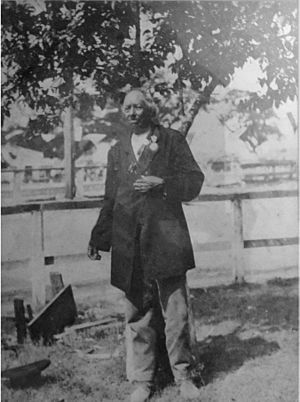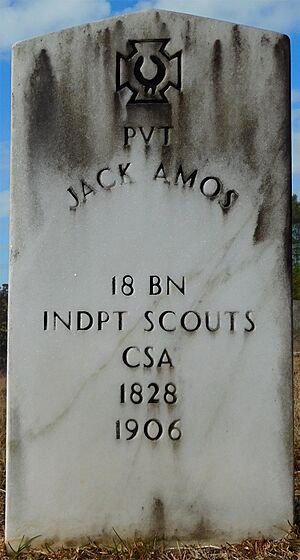Jack Amos facts for kids
Quick facts for kids
Interpreter/Private
Jack Amos (Eahantatubbee)
|
|
|---|---|

Jack Amos' Indian name was Eahantatubbee ("He Who Goes Out And Kills")
|
|
| Birth name | Unknown |
| Born | c. 1828 Lost Horse Creek found in present-day Lauderdale County, Mississippi |
| Died | 1906 Newton County, Mississippi |
| Buried |
Unknown
|
| Allegiance | |
| Service/ |
|
| Years of service | 1861–1865 (CSA) |
| Rank | Private |
| Unit | 1st Choctaw Battalion and Spann's Independent Scouts |
Jack Amos (born around 1828 – died March 1906) was a Native American soldier and interpreter. His Choctaw name was Eahantatubbee, which means "He Who Goes Out And Kills." During the American Civil War, Amos worked as an interpreter for the Confederate army. He served in the 1st Choctaw Battalion and Spann's Independent Scouts. Later in his life, Amos started a big lawsuit that went all the way to the U.S. Supreme Court.
Contents
Early Life and Background
Jack Amos was born around 1828 in the Choctaw Nation. This was before many Choctaw people moved west of the Mississippi River. His birthplace was near what is now Marion, Mississippi. His parents were Apatomby and Nahhatema. When he was a baby, his family moved to a village called Chunky Chitto.
Amos likely went to a missionary school. There he learned to speak English well. He became known for being able to translate between English and Native American languages.
A book written in 1894 described Jack Amos. It said he was about 60 years old and had a wife. He was also said to be in poor health. The book mentioned that he had seen the Choctaw people in their traditional ways. It also noted that he became a Christian preacher later in life. He was respected by his people.
Service in the Civil War
Jack Amos served in the 1st Choctaw Battalion. Later, he joined Spann's Independent Scouts. He was a brave soldier who helped during a terrible train accident. This was the Chunky Creek Train Wreck.
A magazine called Confederate Veteran Magazine wrote about the wreck. It described Amos as a hero who helped rescue people. The article said that when the cry for help went out, every Native American soldier rushed to the scene. Jack Amos showed great courage and loyalty to the Confederate soldiers. Another Native American soldier, Elder Jackson, also helped a lot.
Amos said he joined the army in April 1861. By 1863, he was working as an interpreter. He helped Major John W. Pierce and Major Samuel G. Spann. Amos was probably with the 1st Choctaw Battalion at the Battle of Ponchatoula. He surrendered in Meridian, Mississippi in 1865.
Later Years and Legacy
Jack Amos lived the rest of his life in Newton County, Mississippi. He did not own his own house. Instead, he lived with different families in the area. Records show he stayed with Thomas J. Reynolds and Evan S. Gilbert.
In 1901, Amos joined a group for Confederate veterans. It was called U.C.V. Camp Dabney H. Maury, No. 1312. This group was based in Newton, Mississippi. He even went to a reunion in New Orleans in 1903. A newspaper there wrote an article about him. It called him a "FAMOUS INDIAN SCOUT." The article said he was a "heroic red man" who helped the Confederacy. It also mentioned he was 73 years old and a full-blooded Choctaw.
Jack Amos passed away in March 1906.
Fighting for Land Rights
Jack Amos played a big part in helping his people get their land rights. This goes back to the Treaty of Dancing Rabbit Creek. This treaty was signed by Choctaw leaders in September 1830. Article 14 of the treaty said that any Choctaw who stayed in Mississippi could become a U.S. citizen. They would also be given 640 acres of land.
However, the U.S. government did not properly follow this part of the treaty. Many Choctaw people who stayed in Mississippi did not get their land. For many years after 1830, people sent requests to fix this problem.
The Dawes Commission
The Dawes Commission was set up to divide tribal lands in Indian Territory. The goal was to give individual tribal members their own plots of land. At first, the Mississippi Choctaws were not included in this plan. But soon, they were allowed to apply. About 25,000 people applied to be recognized as Mississippi Choctaws. Only about 2,500 were officially identified.
Lawsuits for Justice
Jack Amos led a group lawsuit to get land for his people. He wanted them to receive land in Mississippi, not in Indian Territory.
Amos and other Mississippi Choctaws filed a lawsuit. It was called Jack Amos et al vs. The Choctaw Nation. This case was heard in the U. S. Court of Central District of Indian Territory.
Supreme Court Decision
The case eventually reached the U.S. Supreme Court. It was named WINTON v. AMOS. The case was argued in January 1919 and again in April 1920. A final decision was made on March 7, 1921. Justice Mahlon R. Pitney delivered the court's opinion. This decision was important for the land rights of the Mississippi Choctaw people.


